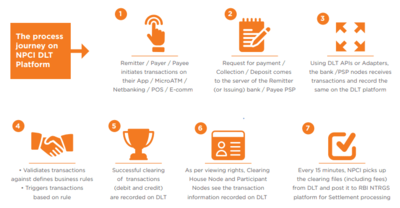NPCI Officially Announced Permissioned Blockchain-based Vajra Platform for Payment Industry
- 1163
- 4
-

- Last Comment
NPCI Officially Announced Permissioned Blockchain-based Vajra Platform for Payment Industry:
Unlike other countries that are becoming more open to the idea of the nascent crypto-blockchain industry and its benefits, India’s view has always been baffling. Although, earlier reports indicate how India’s most significant organization NPCI flirts with Blockchain for payment, the more recent report officially published by NPCI details about its forthcoming DLT-based project for the payment industry.
How is NPCI Leveraging Blockchain Technology?
NPCI (National Payments Corporation of India) claims itself as “an umbrella organization for all retail payments in India.” India’s central bank supports the organization, the Reserve Bank of India (RBI) and the Indian Bank’s Association (IBS).
Notably, NPCI’s own instant payment system called Unified Payments Interface reached a milestone after crossing a billion transactions in October this year. While UPI is simply a money transfer mechanism on top of existing IMPS payment systems, India hasn’t upgraded to a level that other countries are already waving their digital payments.
Technologists and experts in the digital payment industry often talked about the need for a new paradigm in the Indian banking system, given the fact that India is a home for over a billion people. Consequent to the recent official press released by NPCI, it appears that India is quietly adapting the blockchain-based payment mechanism.
NPCI Announces DLT-based Vajra Platform
The 17-page long report details “a distributed ledger system for automated payment, clearing & settlement” dubbed as Vajra Platform.” Unlike Permissionless blockchain, the so-called Vajra platform is built on top of “permissioned network” means that the parties intending to involve need approval by the Network administrator.
Since Vajra is being developed for a payment processing industry, permissionless blockchain systems were not considered, NPCI said in a blog. After an initial assessment, the DLT based system has been designed for automating payment clearing and settlement processes of NPCI products.
More so, the Vajra frameworks seek to ensure zero/minimal processing time for reconciliation, faster resolution of disputes, implements cryptography to increase the security of payment transactions by leveraging the maximum advantage from the Blockchain framework. The working mechanism/architecture of Vajra is detailed as follow;
https://www.npci.org.in/sites/default/files/Vaj...
The Vajra platform will be accessed by multiple payment entities for performing transactions via web interfaces. The bank nodes will receive requests from APIs and will process it on Vajra. The system will have self-executing contracts containing business rules. After successful processing of the requests, the on-chain data (eg. Hashes of the transactions) will be added to the ledger
Furthermore, the participants will carry a node in the network, and the data will be accessible only to the node (the participant with node basically). Accordingly, NPCI details three types of nodes on the platform, namely, Clearing House node (CHN) for NPCI, UIDAI node for Aadhaar authentication, which is only applicable in case of biometric authentication, and lastly Participant node (PN) for all banks/ASP/PPI/PSP.
Besides, NPCI elaborates payment processing via the Vajra framework in 7 simple ways, noting that the platform is majorly designed for automation of the clearing and reconciliation process at NPCI and its partner banks/ASPs.
In a short note, NPCI also remarks that they will be able to detect frauds using AI and ML, which will soon be executed against ledger data.
Also, the Vajra framework promotes transparency in terms of real-time visibility of transactions, reduces the time required for the clearing & settlement cycle as well as the other activities, including reconciliation and reporting. With the permission blockchain network, NPCI also ensures to break-down the unrelated parties currently involved in the clearing and settlement process.
DLT HASH creation for UPI 4-party Push scenario:
Let us depict the DLT transaction flow using a real-life scenario:
Remitter with VPA abc@ybl on PhonePe app sends money from his Axis bank A/c
Beneficiary with VPA xyz@oksbi on Tez app receives money into his RBL bank A/c
Step 1: PhonePe Server to make APIs calls to Yes Bank PSP PN for checking the Node Status.
Step 2: Yes Bank PN will send status response to PhonePe server.
Step 3: PhonePe Server requests for Validate Address to Yes PSP PN for VPA resolution of the Payee/Beneficiary.
Step 4: A smart contract for VPA resolution will trigger and will check for the following:
a) If(Bene details contains @ oksbi)
b) If(SBI is alive as per latest Heartbeat Notification)
Then post VPA resolution notification on VAJRA for SBI PN with data as xyz@oksbi
Clearing House Node will also be notified for providing consensus.
Step 5: SBI PSP PN validates address and resolves the beneficiary details corresponding to xyz@oksbi from
its off-chain DB and posts Beneficiary A/c No., IFSC and MBIN on DLT.
Step 6: On receiving DLT notification, Yes Bank PSP PN sends details to PhonePe App via API and also
requests Amount, UPI Pin and Debit Confirmation from user.
Step 7: PhonePe app channel server makes API call to Yes Bank PSP PN with the Beneficiary Address and
Amount.
Step 8: On receiving request for payment on any of the PN, it will trigger Smart Contracts to check for NDC
limit of Axis & RBL and (FRM check) will fetch the FRM score. The response from both will be captured in a
message.
Step 9: If NDC and FRM are successful, Yes PN posts Debit req. notification on the DLT to Axis PN.
Step 10: On receiving Debit request, Axis PN makes Debit API call to Axis CBS for UPI Pin Validation and
balance check. If successful, then A/c is debited and the same is posted on VAJRA by AXIS PN as Debit Success message.
Step 11: On being notified about Debit Success, RBL PN makes Credit API call to RBL CBS.
If PN receives successful credit message, then RBL PN posts on DLT the Credit Success message.
Step 12: Yes PSP PN sends success message to Axis Channel Server using API call.
Step 13: A Smart Contract for NDC Limit Update will get triggered in the network after RBL PN receives message then NDC will be updated and broadcasted to all the Participant nodes and CHN.
Step 14: A Smart Contract for Calculation of Fees will get triggered at the end of every 15 mins for all transactions at CHN. It calculate fees and generate a message to the concerned parties involved in transaction
Full details - https://www.npci.org.in/sites/default/files/Vaj...
- Sort By
Yes, also reduce UPI failed transaction & fast dispute on IMPS, UPI, RuPay card & AePS.
Hope ispe kuchh badhiya product aye, ya existing me sahi se integrate kar paye




















Good step,hope to see reduction in frauds if implementation of AI & ML is done properly.Should be able to completely track the fraudsters distributing & diverting money to different accounts.